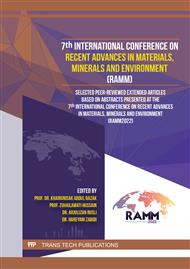p.149
p.155
p.167
p.175
p.183
p.189
p.197
p.209
p.219
Evaluation of Rock Mass Rating in Underground Mine Bukit Kachi Using UAV Photogrammetry Method
Abstract:
This paper describes the results of a field investigation with the objective of evaluating the possibility to produce drone-derived 3D digital point clouds sufficiently dense and accurate to determine the rock mass rating (RMR) in the underground mine in Bukit Kachi. Agisoft Photoscan software was used for producing the three-dimensional points cloud from the two-dimensional images' sequences. The rock mass rating was evaluated by using Discontinuity Set Extractor (DSE) and Dips 7.0 in Rockscience software. Results from this research show that 3D digital point clouds, derived from the processing of drone-flight images, were successfully used for reliable representation of discontinuity of the tunnel. According to the results of the analysis, both Tunnel A and Tunnel B are classified as "fair rock." Meanwhile, Tunnel A is failing due to geological conditions of feldspar decomposition that are classified as class I, which is "very poor rock." According to Dips 7.0 analysis, the major direction of discontinuity set of Tunnel A for Window right is N300 – N310, while for Window left is N350 – N360. The most dominant discontinuity direction for Tunnel B Window right is N340 – N350, and the orientation for Window left is N10 – N20. When manual mapping and DSE analysis are compared, both orientations of the discontinuity do not give the same direction due to less data reading in the field and high accuracy from the software.
Info:
Periodical:
Pages:
189-196
Citation:
Online since:
March 2024
Keywords:
Price:
Сopyright:
© 2024 Trans Tech Publications Ltd. All Rights Reserved
Share:
Citation:



